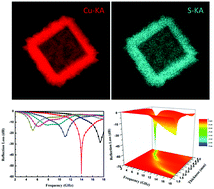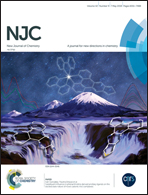Hollow cube-like CuS derived from Cu2O crystals for the highly efficient elimination of electromagnetic pollution†
Abstract
In this study, hollow cube-like CuS composites derived from Cu2O crystals were synthesized via a simple one-step reaction. The formation of hollow cavities can be explained through the Kirkendall-based process. The morphologies and electromagnetic absorption (EA) properties of the CuS were measured and investigated. A sample with 35 wt% hollow CuS loading paraffin-composite achieves an optimal reflection loss (RL) of −63.99 dB at 12.09 GHz under the thickness of 2.25 mm. Simultaneously, the effective EA bandwidth (RL ≤ −10 dB) can be tuned between 4.63 and 18.00 GHz by changing the thickness of the absorber from 1.5 mm to 4.0 mm. The excellent EA performance is attributed to the high dielectric loss, appropriate impedance matching and multiple reflections induced by the unique hollow cube-like structure. Thus the hollow cube-like CuS is expected to be a promising material in approaching for microwave absorption against the electromagnetic pollution.



 Please wait while we load your content...
Please wait while we load your content...